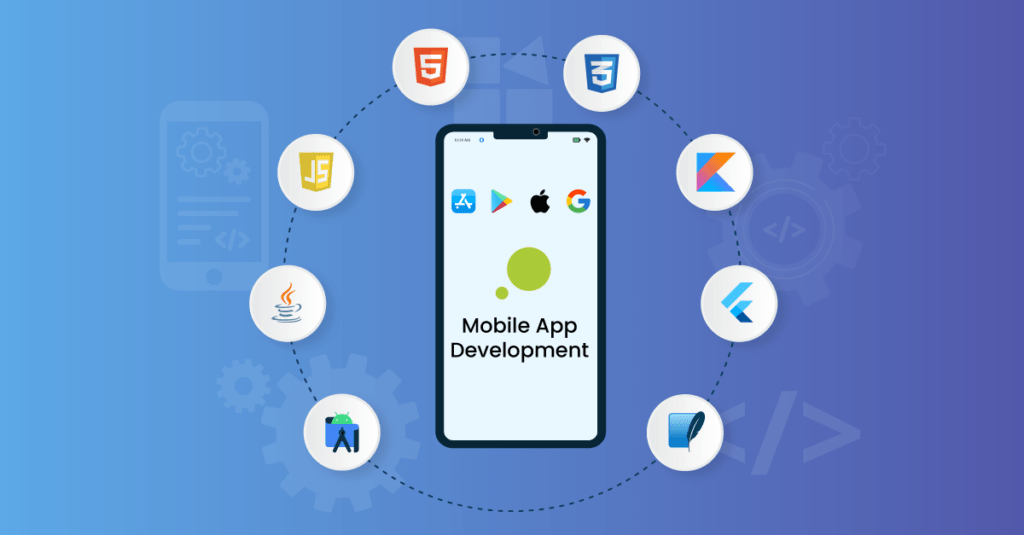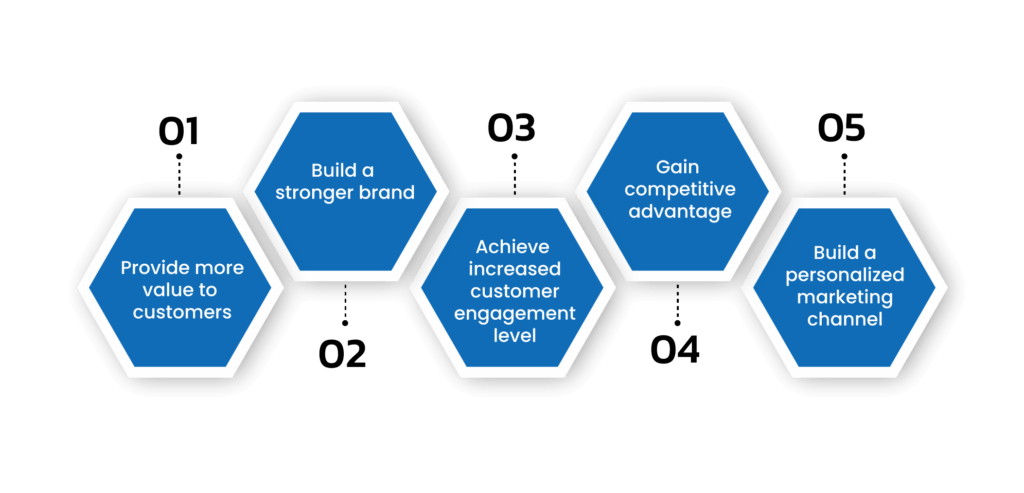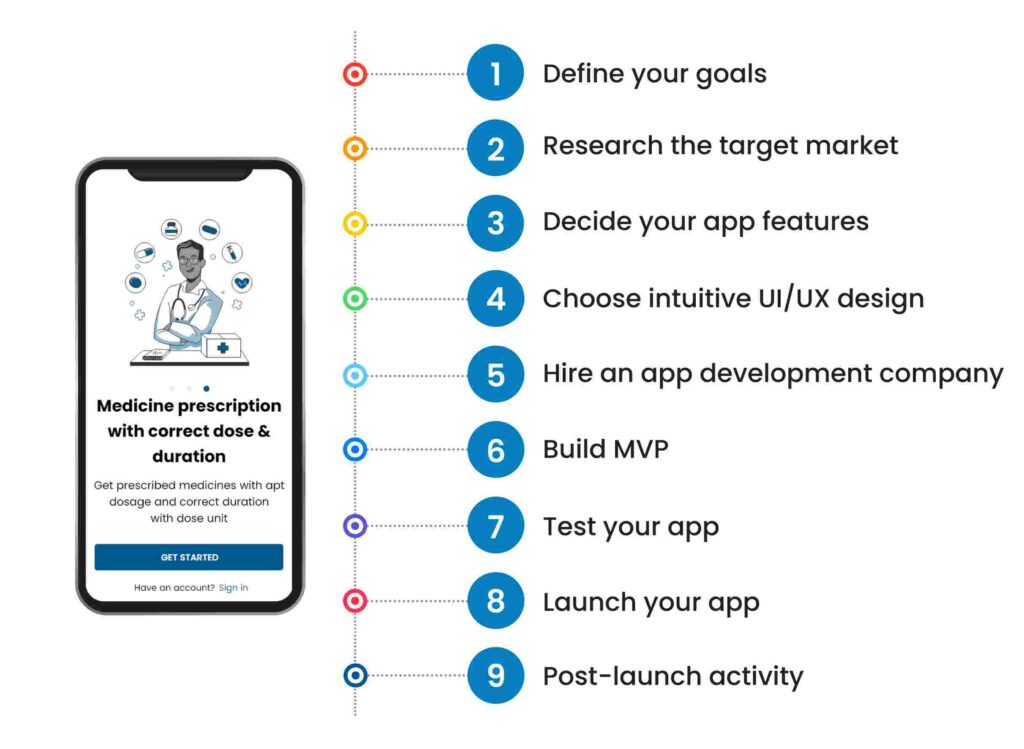A Complete Guide to Mobile App Development
The mobile app development process makes software for wireless, small computing devices like digital assistants, mobiles, enterprise digital assistance, and tablets, mostly in operating systems like Android and iOS. The mobile development process involves creating installable software bundles containing essential things like code, binaries, assets, etc., implementing BE(backend) services such as data access with an API, and testing the application on target devices.
Like web application development, mobile app development has its root in more traditional software development. Considering several hardware constraints, such software applications are specifically designed to be set up and run on mobile devices.
Typical constraints which are computers include central processing unit architecture and speeds, available random access memory, limited data storage capacities, and considerable variation in displays with different constraints like technology, device size, dimensions, resolution, and input methods like touch screens, buttons, and keyboard, with or without styles.
In mobile application development, UI design of mobile is one of the essential steps in the creation of mobile apps. Mobile UI designers consider constraints, screen size, portrait or landscape (screen orientation), contexts, screen space, and input methods as outlines for design.
Mobile app development is done in various technologies like native Android, native IOS, react-native, and Flutter. The native Android uses kotlin, java, SQLite, android studio, and the latest jetpack compose framework. Native IOS uses swift, objective-c, Xcode, and key-chain. React-native uses javascript, typescript, JSX, TSX, and native support also, whereas Flutter uses dart language and google support.

Why Should you Build a Mobile App?
To enhance the business, we need to use digital services. Under these things, we can create web apps and mobile apps too. But according to your budget and business target, you may have to select one option.
Each channel has its own benefits and disadvantages. But mobile applications are something that provides higher conversions and retention. Along with these features, we get operational efficiency & personalization too.
With increasingly advanced technology, business is also rapidly growing speedily. Now mobile applications are becoming a crucial part of business growth. The mobile app industry is growing rapidly but has not reached its peak.
Still, according to data from the Swiss market, Statista, Switzerland is the country where the second-largest use of mobile applications after south korea since mobile app companies are rapidly growing in this area of business.

Provide More Value to Customers
People now rely heavily on technologies and mobile phones since business owners also have the best way to connect with their customers and provide better service. With the increasing technological advancement, some expectations are also increasing, opening opportunities for better service to consumers; mobile applications are the best way to meet these expectations.
For example, if there is a business like retail shopping. In this case, if you are providing service with a mobile application, you are saving time and resources for consumers, which adds value for them.
Build a Stronger Brand
Mobile apps are significant elements of new technology that continuously change how customers shop and satisfy their requirements. It boosting Customer Relationships 78% of consumers prefer to save time by shopping on their devices, and most smartphone users choose mobile apps instead web apps.
Mobile applications are not independent of revenue brands like Bank of America and Walmart. Small-scale and mid-scale companies follow mobile application strategies and understand that basic mobile strategy involves more than just a mobile-friendly web app; these observations give remarkable results.
Mobile apps are much more convenient to access than web apps. Also, Some apps are even accessible without the internet.
Achieve Increased Customer Engagement Level
Keeping people busy throughout the customer journey allows companies to build relationships and brand loyalty and improve customer-critical sales metrics. These include cross-selling and upselling lifetime value. Ultimately it actively keeps busy consumers buying the brand product more frequently over time.
First-time visitor customers are just the tip of the iceberg because genuine consumers create brand experts who can attract a bunch of new customers. The market for mobile applications is increasing rapidly. According to studies, people spend more time on mobile than on web apps. Since if companies cover the mobile side, it will keep more customers busy over web apps.
Have a Competitive Edge in your Niche
Mobile apps ultimately connect us with the market. With this service, we can connect with many consumers, and if we get that trust and connect with our customers, we can have the edge over the business competitors in our niche. Nowadays, there is no business where mobile apps do not serve services. In each sector, mobile apps are involved, and they are very useful for boosting our business.
Since COVID-19, consumers have also gotten used to transacting each service online; in this case, everyone prefers to go with mobile apps instead of web apps all the time.
Also, the new age algorithms are out there which understand user usage and give us proper analytics over consumer’s interest which really helps us to grab opportunities and capture the real interests of consumers in the crowd of competitors.
Build a Personalized Marketing Channel
In today’s world, mobile is the most essential and critical part of human life. Everyone is available on devices 24/7. Due to this, it became the best way to attach with consumers and the best medium to communicate and connect with consumers. Due to the continued availability of everyone, it made the best way for marketing.
Also, with today’s new age algorithm, we can understand personal interest by which we can only do rapid and aggressive personalized marketing on that specific factor. This thing will help us to provide personalized services to consumers.
Also, according to the 80/20 rule, 80% of customers generate revenue from 20% of goods and services. Since we get those things, it will raise our business, and we can also focus on that sector of marketing.
Type of Mobile Apps–
Native App Development Revenue Comparison
As of quarter 3 of 2022, the google play store is offering tentatively 3.55 million mobile applications. On the other hand, IOS offers around 1.6 million apps on the app store. Android and IOS are the operating systems with a duopoly in the market.
Android captures around 70% of the market, and IOS captured tentatively 28% as of the end of august 2022. Like this, Europe doesn’t have that much change in percentage; it is 32% and 67% in IOS and Android, respectively.
Still, regarding revenue, IOS is ahead of Android while the count goes globally. Studies and statistics said that apple reached $85.1 billion in 2021. In contrast, play store apps amounted to $47.9 billion. But ultimately, combining these revenues is higher than other portals or services.
Cross-platform App Development
The concept of cross-platform mobile applications is something that applications can run on any mobile operating system. Complex building backend blocks compound this complex architecture of creating such applications by frameworks. So that such applications could run on any operating system of mobile devices; because of this framework, we can create multi-platform dynamic applications.
As mentioned above, using such an approach has many more benefits, such as time savings, efficient work, and saving the total cost of development.
Progressive Web Apps
Progressive web apps are something where the qualities of mobile apps and web apps get combined. The combination of both features is all Progressive web apps.
For creating such progressive web apps, technologies such as javascript, typescript, HTML, CSS, and web assembly tools are used.
Web apps don’t need specific operating systems. They need browsers, and they are already cross-browser-compatible applications. Also, they could run on Android, ios, desktops, and tablets anywhere. They differ from the kind of software that needs to be installed from the google play store or app store. We can directly fetch it from the browser.
Hybrid Mobile Apps
When it comes to hybrid mobile applications, many people interchangeably mention cross-platform and hybrid development as the same. And that is true in some way, but not entirely.
When discussing cross-platform, it’s like writing code once and running it on different device platforms. On the other hand, hybrid applications are written code in the web format using HTML, CSS, and javascript/typescript. And they are compatible to run a web and mobile OS using frameworks like IOnic capacitors and Cordova. Code shareability is the only fundamental similarity between hybrid and cross-platform mobile applications.
Platforms Used for Mobile App Development-
When developing software based on mobile and web platforms, the public thinks it must be a complicated and complex process for code base and interface designing, which is partially correct.
But today, some frameworks have made this process easy, convenient, and optimized, Which is a key feature of such technologies. Creating things, debugging them properly, and testing it will also deploy them accurately. All things come under the same umbrella with this framework. There is a considerable number of companies who are adopting this framework and increasing the rate of development.
- Native mobile app development tools: They can help to create native feature which allows making changes from native source and does not need external packages, which make applications ultimately optimized.
- Cross-platform mobile app development: These tools are sorely based on concepts that write code once and run it on multiple platforms, saving money and time. In other words, it’s a generic code implemented on both platforms.
Android
The native Android mobile application is get created under the android studio. Android studio is the integrated development kit used to develop android applications.
Based on the powerful code editor IntelliJ. The native Android uses Kotlin, java, SQLite and the latest jetpack compose framework. Initially, java was used for integration; after that shifted to the Kotlin language.
IOS
The native iOS mobile application is get created under the Xcode IDE. XCode is something that only runs under the mac operating system. It is the mighty IDE that has robust tools which help with development.
Under the code, iOS app development happened in objective-c language. After that, the swift language came, and now the latest swiftUI toolkit is used. Native IOS apps only run on iOS devices.
React Native
The react-native framework which based on react library created by Facebook. This is the hybrid and cross-platform application development environment. Once we code in this environment, it can be run on both Android and IOS platforms. Typescript, JSX, and TSX languages are used in this framework javascript.
Many companies are started using react native because it saves time and cost. Also, those resources can assign to another sector which helps for faster growth.
Flutter
Flutter is the technology developed under google support and tools. This is the hybrid and cross-platform application development environment.
Once we code in this environment, it can be run on Android and IOS, both platforms. In this framework-dart, languages are used. This environment has a wide range of active support. There are plenty of packages out there which help to develop applications with 2X speed.
Mobile App Development Process-
The mobile application development process is the same as any software development model. There are several models out there for development, which same follows.
There is a waterfall model. Under this model software development life cycle goes in linear ways, one after another serially. This process has several nodes: analysis, design phase, development, testing, and maintenance.
Also, there is another model, which is the spiral model, where things go in a spiral that process goes a spiral form. Once the process is done, it starts again and redefines ideas and strategies in that form.

Redefine the Idea and Strategize
As I mentioned above, the spiral model is something where things go in spiral form. Various phases of the software development lifecycle like analysis, design, development, testing, and maintenance. TheseThese phases run sequentially in the model, redefining ideas and strategies like a spiral design once it is done.
Market Research
This is something that comes under the analysis phase. Before creating any product, market research is one of the vital elements. While creating applications taking ideas from each competitive product is the best practice.
With such research, things will get easy to understand, and the picture will get clear for our goal. Also, research helps to understand the market’s requirements from a consumer perspective.
Build your UX Design
This section comes under the design phase of the software development life cycle. Creating designs in figma or wireframes for the application will give us a virtual idea of the look and feel of the application. Also if we added page navigation under this, then clear picture we will get of the execution of our application.
App Development
This is the next phase of the software development life cycle. This part contains the core operation of software development: actual development. There are many platforms; IDEs are many more tools for successful development.
Frontend and backend development both come under this phase. Once we get a design from a previous design, this phase will initiate and send the execution of the process to the next section, which is testing.
Test Your App and Improve
As in development, there is one saying that no system is perfect and no application can be bug-free. But we can reduce bugs and keep it as clean as possible. And in this process most crucial role is getting plays by the testing phase.
Testing is a crucial step in development. There are various types of testing, such as manual testing, regression testing, and sanity testing. This all comes under this vital phase of testing.
Launch a Beta Version of your App
Once the software is designed, developed, and tested by various tools, it’s ready to go for those who created this application since we need to deploy it to stores to get available to the world.
Deployment is the next section of our software development lifecycle process. To deploy android applications, we have the play store, and to deploy IOS applications, we have an app store. We need to get reviews from stores, and then we can release it for everyone.
Launching your App
Once the stores approve the App, we can launch it for everyone. But initially, it’s an MVP. Since we can call it a BETA VERSION which ends users, do not use, and it’s the first model introduced to users. So that part comes under this launch application part.
Post Launch Activity
Post-launch activity is coming under the last phase of SDLC, maintenance.
Once the application gets life, the user starts using that service. In that case, it’s very important to be bug-free; if some critical bug is aroused in some cases, that should get resolved in significantly less time since this is the most crucial phase of SDLC. Maintenance is also the starting point of new upgrades and issue resolving phase.
Why Should you Outsource Custom Mobile App Development–
Outsourcing the custom application is the best way because if you decide to do it by yourself, you may need to find some talented developers and train them according to your requirements. Instead of that, you can prefer one thing: hire people who are already aware of the process of the concept and experienced in the system.
Instead of wasting time on these things, you can focus your efforts and money on business development and ideas. If you go with outsourcing, you will get a massive talent pool and expertise.
There are several points which we mentioned above also but to summer up things they are as follows:
- Time will be saved due to no need to train developers.
- Cost save of infrastructure and team building costs.
- You will only need multiple developers if you get an already-trained full-stack developer who knows the process.
- You can be focused more on core business strategies and plans.
- You will get a customized application as per your requirements in no time.
- You can launch the App as quickly as possible due to the expertise of developers.
Conclusion
The digital world is growing out there, and we cannot deny that by using these technologies, we can grow our business faster with 10X speed. And in this digital world, there are so many ways to reach out to consumers, but mobile applications are the most incredible way to interact with them. Since use, this powerful technology has been the most innovative way to grow your business and be the best in your industry.
For any questions and inquiries, visit us at thinkitive




